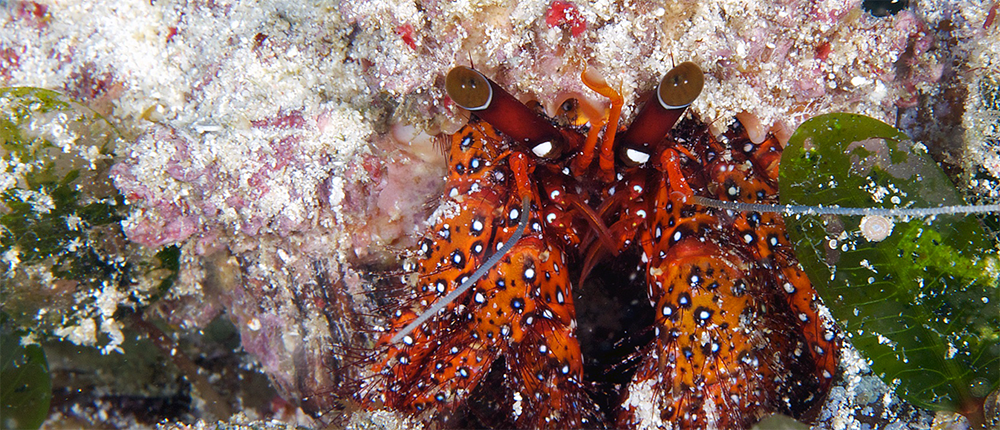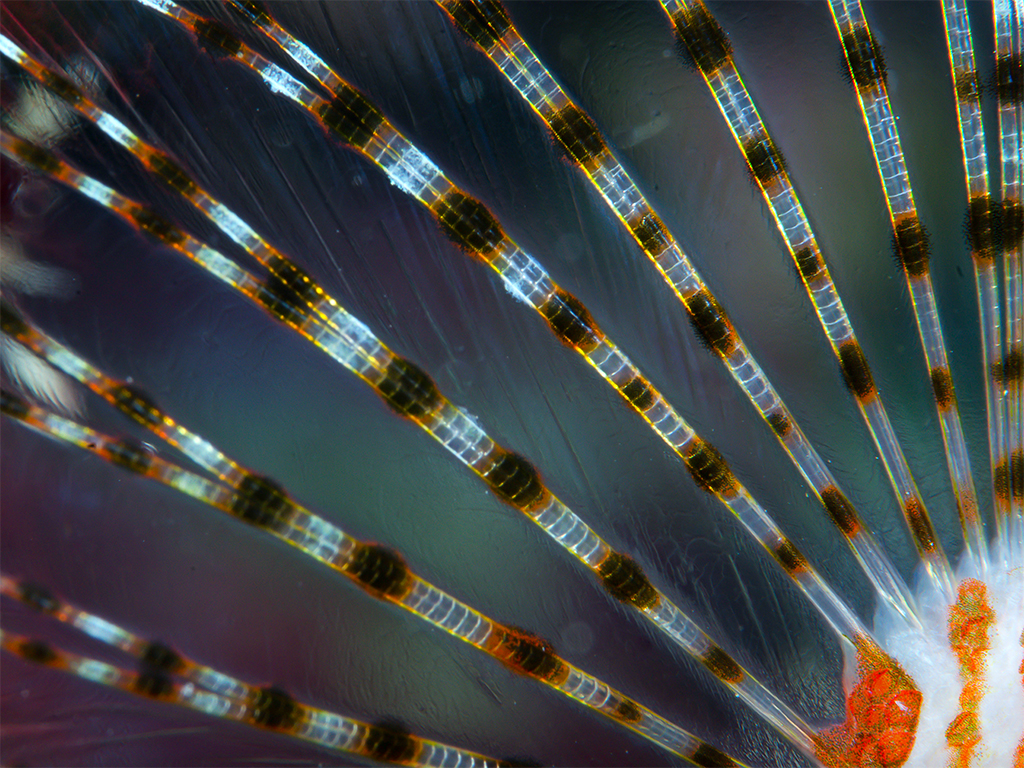Survival of the Fittest, or Most Creative
The ocean is a vast expanse of calm and serenity, a beautiful haven for those who are lucky enough to marvel at. Yet for its myriad inhabitants, this vastly serene environment can rapidly become unforgiving. From feeding, to finding a safe refuge, to escaping predation, constant challenges are posed to the marine animals every day. For them, danger lurks behind every corner and they must be forever vigilant and ever more resourceful, as they are repeatedly confronted with finding new ways to survive.
To survive, marine creatures have developed myriad different techniques and anti—predation tactics, and have created numerous physical and behavioral modifications in order to protect themselves, their nest, their territory, their mate or their young.

One survival tactic of the squid is changing colors to blend in with their surroundings; they will also release clouds of ink as a diversionary tactic. Photo by Dr. Claus Meyer
Some animals such as certain nudibranchs have developed ‘chemical’ defenses. One taste of the lovely Hypselodoris Bullocki is usually sufficient to teach a predator that it is a bitter mouthful to covet. Scientists believe that the natural toxins produced by reef invertebrates such as these may have future commercial or medicinal applications.

Even if they are not visible when the pufferfish is not inflated, all puffers have pointed spines, so a hungry predator may suddenly find itself facing an unpalatable pointy ball rather than a tasty fish. Photo by Marina and Victor Zaslavsky
The Pufferfish also has a lethal defense. Puffers generally deter most predators by inflating themselves like balloons, so they appear larger than they actually are — whilst also hopefully being too big to fit into the mouth of a threatening predator! Even if they are not visible when the puffer is not inflated, all puffers have pointed spines, so a hungry predator may suddenly find itself facing an unpalatable pointy ball rather than a slow, tasty fish. But predators that don’t heed this warning (or who are “lucky” enough to catch the puffer suddenly, before or during inflation) find their stomachs full of a highly toxic substance called ‘tetrodotoxin’, making puffers an unpleasant, often lethal, choice of prey. This neurotoxin is found primarily in the ovaries and liver, although smaller amounts exist in the intestines and skin, as well as trace amounts in muscle. It does not always have a deadly effect on the larger predators, such as sharks, but it can kill humans. And if that’s not enough for protection, some have sharp, erectable spines and they bite their attacker as well. Inflating themselves, highly toxic and with a lethal bite, packing a triple whammy, pufferfish certainly make up for their slow swimming, docile-like nature.
Attractive and dangerous, another technique to survive on the coral reef is to have poisonous spines, like those of the spectacular Common lionfish, one of the most beautiful fish on the coral reef. Vividly contrasting coloration warns predators away from its highly venomous spines. Lionfish are part of the family Scorpaenidae, Scorpionfish. Most species in this large family are well camouflaged by flaps, tassels, and coloration matching the bottom terrain. But all the members of this family have one thing in common – the fact that they are all venomous to a greater or lesser extent. Lionfish ambush their prey, and often herd fish, shrimp, or crab into a corner before swallowing.
Like the Lionfish, the Scorpionfish, as the name suggests, has a type of “sting” in the form of sharp spines coated with venomous mucus, which he uses for defense if attacked from above. In addition, he uses his highly effective camouflage to hide ‘in full view’, disguised from his predators, hidden from his prey, who he pounces on with an unsuspecting lunge. Scorpionfish feed by opening their mouth, then their gills a fraction of a second apart, creating suction.
Closely related to the lionfish and scorpionfish, the stonefish is also venomous, but is only a danger to anything that directly attacks him. Unfortunately, he looks very much like a stone and sometimes inhabits shallow waters leaving an occasional unsuspecting human in prime position to stand on him, with potent results. Stonefish are the most poisonous of this family and have potent neurotoxins secreted from glands at the base of their needle-like dorsal fin spines, which stick up when disturbed or threatened.
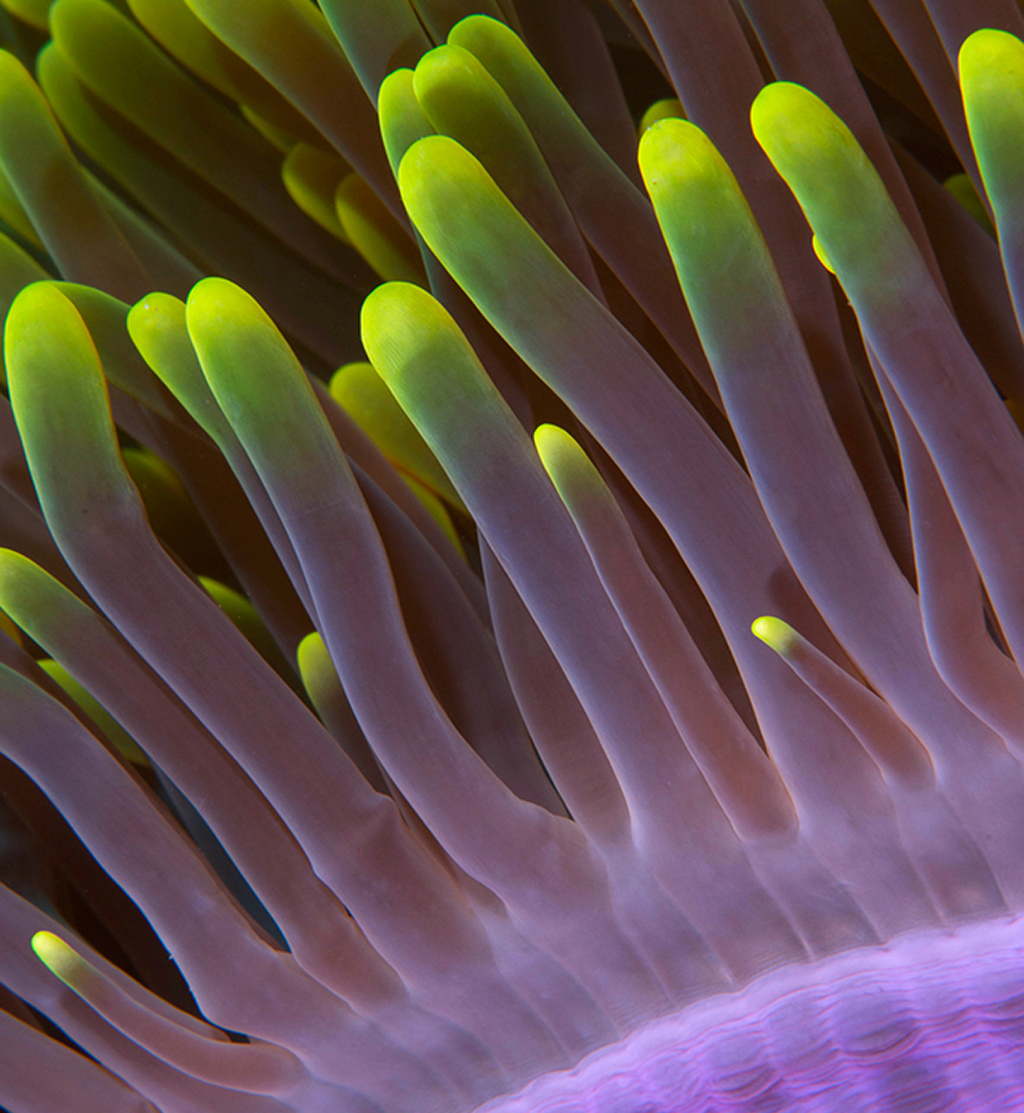
Cnidarians such as this sea anemone all possess stinging organelles called nematocysts. Photo by Richard Smith
The coral reef looks so beautiful, like a vibrantly colorful garden. But any diver who puts his hand in the wrong place will know that even for a ‘big person,’ marine stingers teach us rapidly not to touch! Cnidarians (hydroids, jellyfish, corals, sea anemones and black corals) all possess stinging organelles called nematocysts, which they use for defense. Nematocysts are microscopic in size and are used by this group of animals to capture food and protect themselves against predators. The coral has many microscopic stinging cell filaments or cnidoblasts (the origin of the phylum name ‘Cnidarian’). These cnidoblasts are located in the tentacles, and produce minute stinging capsules with a threadlike organ that can be shot out and into the body of the prey or object. The ‘nemaotcyst’ is the special stinging capsule structure and is used to catch prey (i.e. small shrimp, worms, fish) or for defense. When the anemone or one of the Cnidarians receives the proper stimulus, the nematocysts are fired like mini harpoons, the dart injecting a small amount of painful toxin into the helpless victim, while the thread aids in entangling and holding onto the prey.
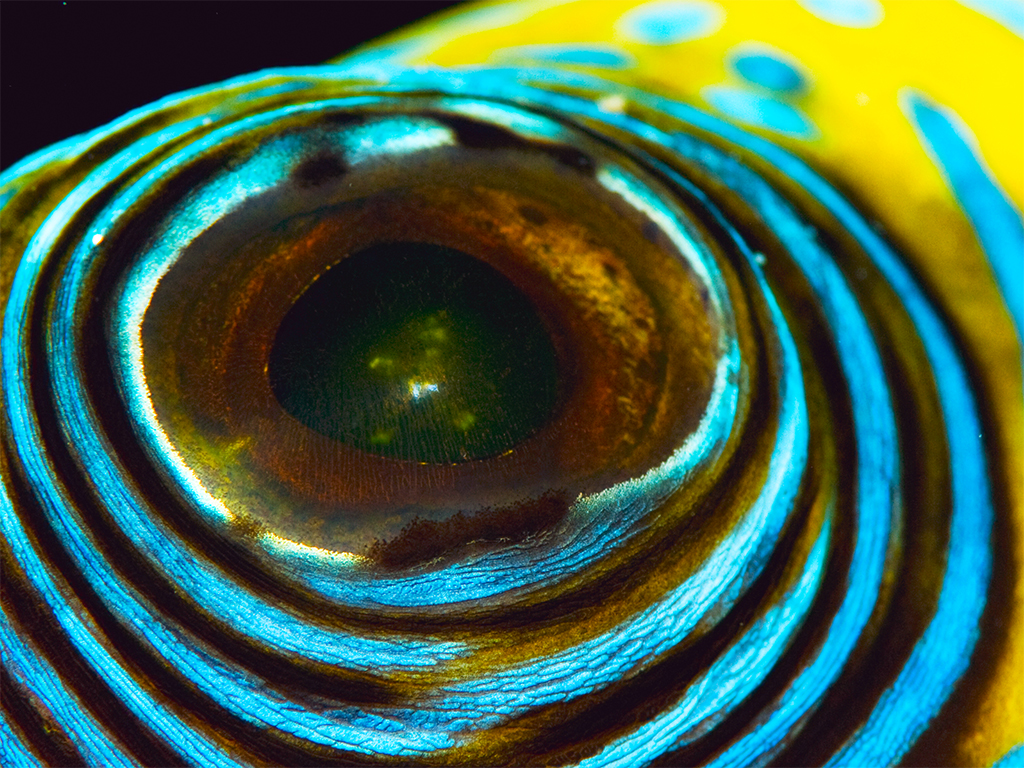
For marine creatures, flashy exteriors like the elaborate patter on on this pufferfish’s eye, are not just for show. Photo by Lisa Collins
Coral reef fish are among the most elaborately ornamented animals on earth. But for marine creatures, these flashy exteriors and flamboyant displays are not only for show. A fish’s protective coloration can have a cryptic appearance, mimicking another animal or a part of the reef, or exhibiting warning colors as a ‘reminder’ to predators that they are toxic. Distinct ‘juvenile’ color patterns confer protection for the youngsters, which would otherwise be mercilessly attacked by adults of their own species. Colors on the coral reef mean crypsis and camouflage.
As life continues on the coral reef, some of the creatures use stingers, venom and chemical defense mechanisms, while others use hard skeletons, shells or flamboyant displays in their incessant game of feed, avoid being eaten and survive. With strong calcium carbonate exoskeletons, crustaceans have a very effective shield against some potential enemies, who would simply not be able to bite through such a hard skeleton to reach the soft flesh inside.
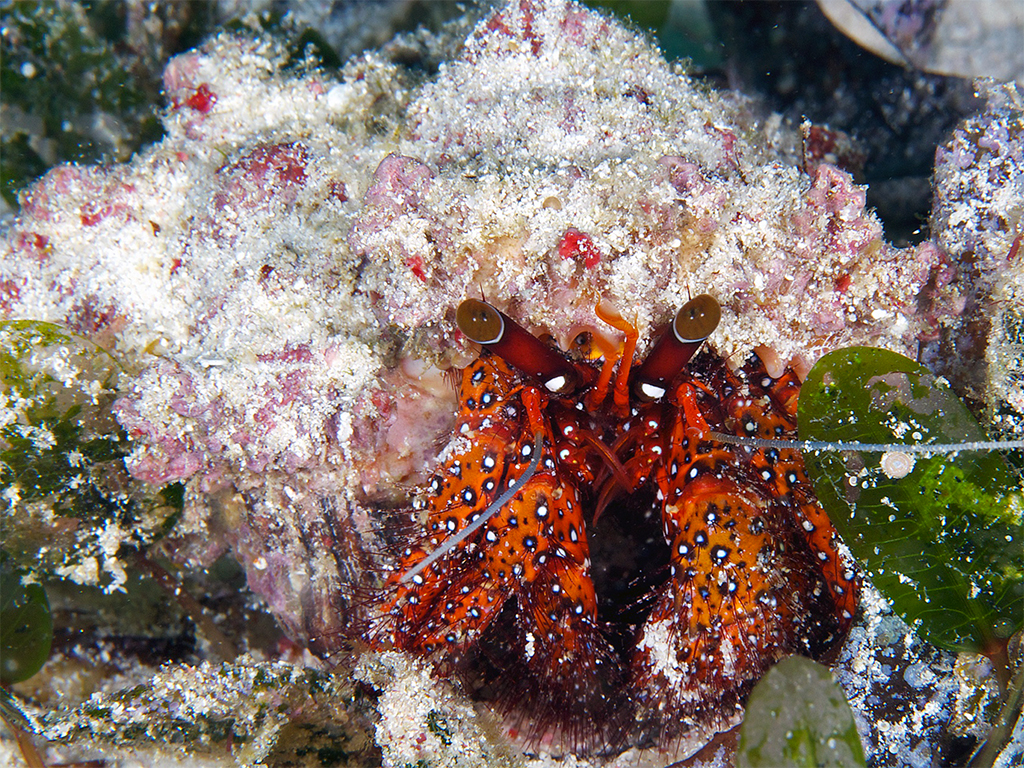
Hermit crabs will hide in discarded mollusk shells, which protect them and become their ‘castle.’ Photo by Adam Wandt
The hermit crab has a soft body. With such soft bodies, hermit crabs would be extremely vulnerable. That’s why they always hide in discarded mollusk shells, which protect them and become their ‘castle’. Indeed, the competition for these safe havens is extensive. One should never remove empty shells from the ocean edge, as there are many who seek an empty shell to live in and protect them, but simply not that many offers lay around. This is prime real estate.
So many coral reef creatures have developed techniques and anti—predation tactics to protect themselves, their nest, their territory, their mate or their young. Yet some creatures don’t have any of these specialized defense techniques at all and have to create ingenious relationships with other species, or learn to live alongside others of the same species in order to continue life and to survive. For example, if you look closely inside a Crinoid, you will find an incredible array of creatures living in this beautiful host. It is not uncommon to find an elegant squat lobster, a pair of crinoid shrimp and even a crinoid clingfish, all living in harmony in the same Crinoid. These little hitchhikers are able to use their host for shelter, transport and food finding. We commonly call them“ commensals”, because they derive benefits from the union, while the host partner is neither helped or harmed.

Commensals often match or camouflage themselves with the colors of their host, such as this Zanzibar Shrimp found on sea whips and black coral whips. The Zanzibar Shrimp grows to a grand total length of approximately 1cm! Photo by Ken Knezick
Let’s not forget the well known, but ever intriguing residents of the anemone, the Anemonefish. Did you know the stem of the anemone’s tentacles is covered with mucus to stop the anemone from actually stinging itself? The anemonefish, and other creatures finding shelter in this fiery home, rub themselves on the tentacles repeatedly, covering themselves with the anemones mucus for protection from its sting. Learn more about anemonefish and their relationship with anemones in Fascinating Symbiosis.
Coral reefs and their creatures have found incredible ways to defend themselves, yet in this vastly serene, yet dangerous world, it is a constant battle of wills – feed or be eaten and find ever new ways to survive.


